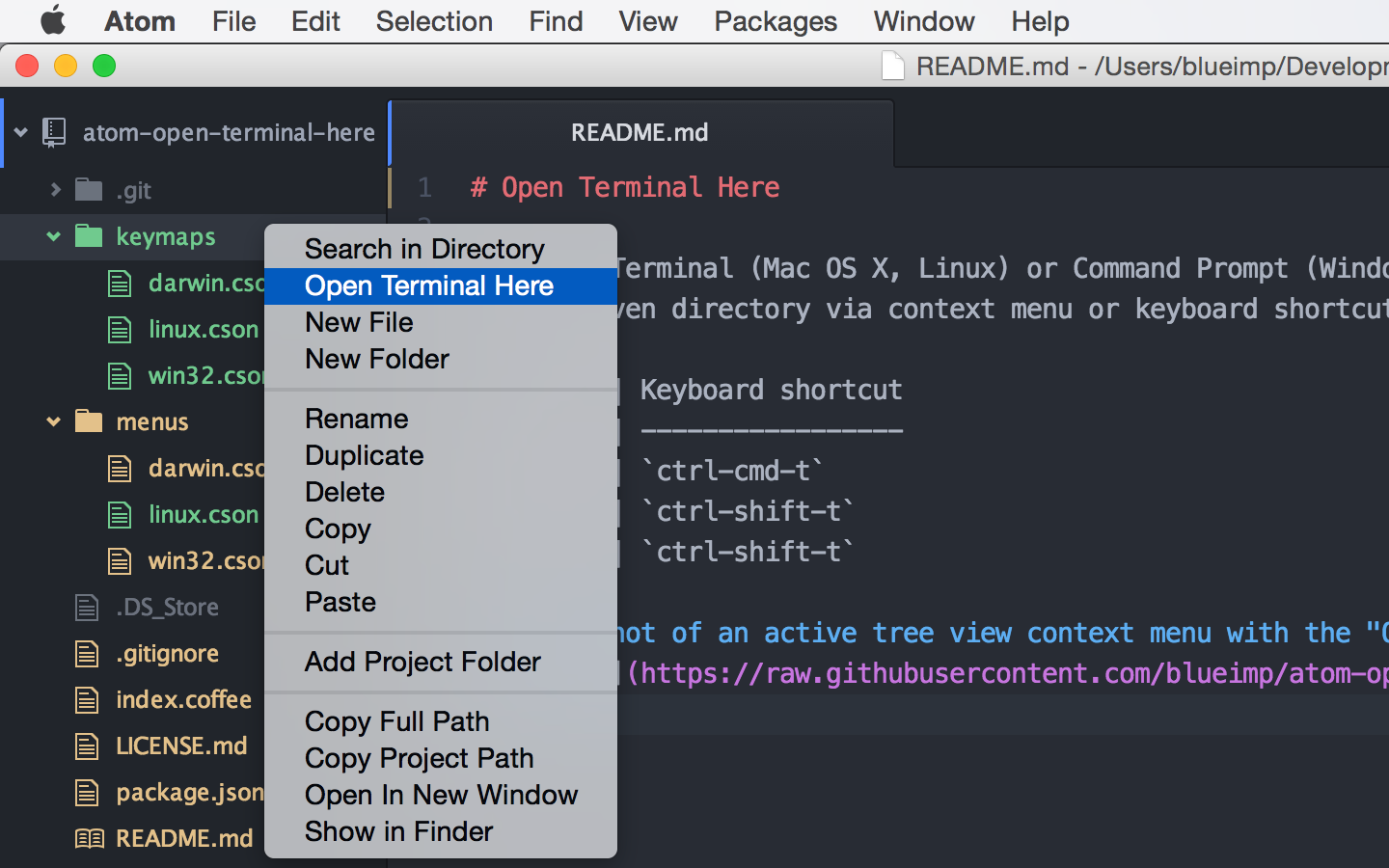

- Macos finder open terminal here how to#
- Macos finder open terminal here mac os x#
- Macos finder open terminal here install#
- Macos finder open terminal here download#
- Macos finder open terminal here mac#
Click the Finder icon in the Dock to open a Finder window on your Mac.The easiest way to see your current location in your Mac’s file structure is to enable the Path Bar in Finder’s view options. The Finder Path Bar shows you the path from the folder you’re currently viewing to the top of the file system. The Finder Path Bar is a small pane located at the bottom of a Finder window, just below where files and folders are listed. The Desktop is the space where you see file, folder, and application windows.) It includes the Finder menu bar at the top of the screen and the Desktop below that. It opens automatically and stays open as you use other apps.

Macos finder open terminal here mac#
The Finder is the first thing that you see when your Mac finishes starting up. (By the way, don’t confuse the Finder with the Desktop.
Macos finder open terminal here how to#
Let’s look at what it is and how to use it. Find Terminal under Launchpad > Other > Terminal, then run the following commands: Type defaults write AppleShowAllFiles true and press Enter. However, there’s also a feature called the Path Bar that can be useful.
Macos finder open terminal here download#
Just download OpenTerminalHere.zip, extract it, move the bundle to your Library/Scripts folder and drag it from there to your Finder toolbar. He published the new version on his site. Ls: The "ls" command, by itself, displays the contents of the cwd.The macOS Finder bar is the default application for viewing and working with files on your Mac. There is an updated version of the very nice and slim Open Terminal Here posted by vgm64 and d0k. This isn’t the only option to open the present working directory from Terminal into a new Finder window on the Mac, you can also use the ‘open’ command like so: open pwd Note that those are not quotation marks but the tilde press instead. If you want to change the shell exit behaviour, see Change Profiles Shell preferences. If anything’s still in progress, a dialogue appears. This ensures that commands actively running in the shell are closed. To actually put all this path knowledge to use, you'll need the Terminal commands for displaying and changing files. By the way, you can also set this up to go the other way, from Finder to Terminal, if you’d like. In the Terminal app on your Mac, in the window running the shell process you want to quit, type exit, then press Return. How to display and move between files in Terminal When I have a Mac Finder window in the foreground and run this script from the AppleScript menu on the. When you first launch Terminal, you're starting in the current working directory of /Users/ myusername/ (also known as your User folder). Here's the code: tell application 'Finder' set myWin to window 1 set thePath to (quoted form of POSIX path of (target of myWin as alias)) tell application 'Terminal' activate tell window 1 do script 'cd ' & thePath end tell end tell end tell. In the search box, type the search query. The finder icon is usually the first icon on the Dock. You can then get to your Utilities folder by typing "./Utilities/" rather than "/Applications/Utilities". To open Finder, click on the icon located on the extreme left on the Dock. For instance, if you go to the "/Applications/" folder in Terminal, that's your current working directory ( cwd). Relative paths are defined based on where you've already navigated to, and represented by "./". So if you wanted to make a path to your Applications folder, you would write "/Applications/". An absolute path starts at the root level of your hard drive, and is displayed as "/". To open Finder in File Provider Extension mode: In.
Macos finder open terminal here mac os x#
The Mac OS X open command can be used in a many other ways as well.
Macos finder open terminal here install#
Heres how to use Homebrew to install Mac apps easily. To open Finder in kernel-based mode: In the sidebar, navigate to Devices > Favorites > Box. For instance, if you have a Mac Terminal window open, and you’re working in the /tmp directory, and you issue this open command, the Mac Finder will be opened, displaying the contents of the /tmp directory. if you select any folder within finder, open the services menu from the. Paths take two forms: absolute paths and relative paths. In other words, open the terminal application and then type the following. here, select the services menu and scroll down to find new terminal at folder. Paths look similar in some ways to website sub-directories, and follow the structure of your folders. As of Mac OS X Lion 10.7, Terminal provides Services for opening a new terminal window or tab at the selected folder in Finder. To do so, you build something called a path. You can use Terminal to get direct access to your files without using the Finder. When writing commands and paths in Terminal, almost everything is case sensitive: This means that you need to remember to properly capitalize "Dock" when referring to the Dock, or OS X won't understand your command.

Unless you're executing a command that requires the display of text in Terminal, you won't have any indicator that what you've done has been successful you'll just get a new line with your user name on it once the command is finished processing.


 0 kommentar(er)
0 kommentar(er)
